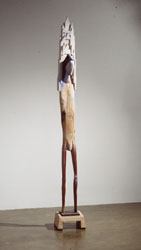A longtime professor of art at California State University, Sacramento, Brady, who was honored with a midcareer survey of his work at the Crocker Art Museum in the 1980s, has seldom shown locally. His current solo exhibition at b. sakata garo, the first at a private gallery in Sacramento since the 1970s, offers a rare chance for local viewers to see a large number of Brady's works. A pair of crude, medium-sized clay figures greet the viewer at the entrance to the show, again calling up associations with Guston in their radically rudimentary appearance. The armless, bundled figures with small heads and muddy, mottled bodies convey the human figure in the simplest terms. And yet they manage to suggest male and female entities and notions of death and mute despair. Brady plays throughout the show with just how little it takes for us to recognize human features and emotions. Placed on a low bench, several ceramic heads with minimal features and application of color take us through a gamut of feelings, from fear and rage to equanimity and acceptance. Other works in clay, including "Mick," the signature piece from his Crocker exhibition, resemble masks from various cultures. "Mick," with its obsessive black-and-white concentric markings and eccentric features, makes one think of Eskimo masks, while "Spider Eyes," a blunt yellow form with red markings where the eyes would be, is like a heraldic Japanese flag in the form of a mask. Brady addresses the full figure, simplified yet remarkably articulate, in two pairs of midsize, mixed-media bodies with long, spindly wooden arms and legs, bent to suggest gateways or arches. Both playful and painful, they are marvelously conceived and crafted images of the body bent under psychic and physical stress. "Vertex," a larger mixed-media figure with a menacing metallic structure on the top of his head, suggests a fierce spirit warrior. "Vesta," a looming female figure made of wooden basketry, unwound down the center to suggest a spinal column with the eye of a needlelike form defining the womb, makes reference to the Roman goddess of the hearth. The austere figure resembles a Gothic representation of a vestal virgin, one of Vesta's priestesses, and by extension a medieval Virgin Mary. Gothic in feeling, too, are a pair of large wood and mixed-media figures with religious overtones. In "Confirmation," Brady gives us a female figure with arms raised in supplication. Atop her head, a series of triangular forms suggest the "mighty fortress" of a Gothic church, rising up to heaven. It's a powerfully emotive piece, as is "Patriarch," a monumental angel, the points of whose wings balance the figure on the floor. This prepossessing figure is subtly articulated and touched with white pigment that gives it a ghostly, ethereal quality. At its feet lies what at first incongruously looks like a bowling ball, but on closer inspection turns out to be an earthy clay sphere with indentations poked into it to suggest eyes. It's almost as scary in its stark simplicity as Picasso's bronze "Death's Head." Here again, Brady reduces the human to its essence, overshadowed by the grandeur of the angel, but enduring nonetheless. Brady also shows a trio of collages with raw figures drawn and sculpted on grounds of intricately printed fabrics and rich papers. Pitting abstract and figurative images against each other in ways that are both playful and compelling, they emphasize his considerable skills as a colorist and draftsman, qualities evident in all the works in this remarkably fine show. WHERE: b. sakata garo, 923 20th St. INFORMATION: (916) 447-4276
Getting it
|

